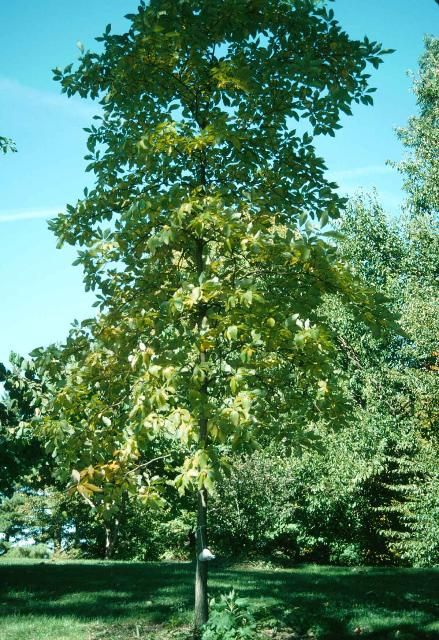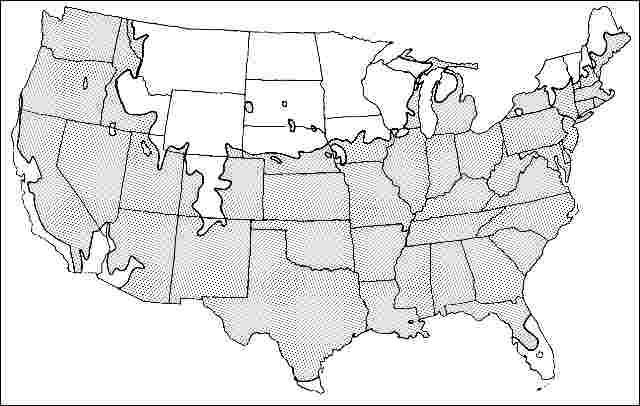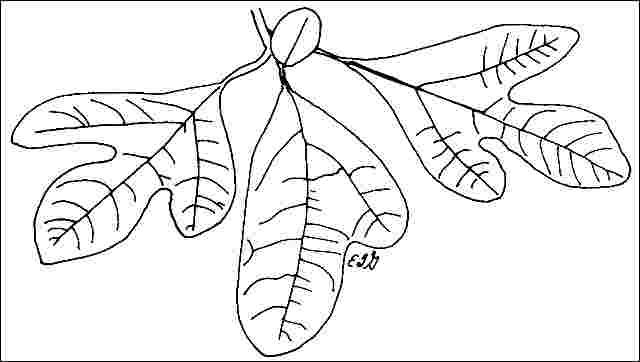Introduction
This lovely, deciduous, native North American tree is pyramidal when young but later develops into a 30- to 60-foot-tall by 25- to 40-foot-wide, rounded canopy composed of many short, horizontal branches which give the tree a layered effect. For years, sassafras was grown for the supposedly-medicinal properties of the fragrant roots and bark but it is the outstanding fall display of foliage which should bring it into the garden today. The large, multi-formed, five-inch leaves, fragrant when crushed, are bright green throughout the summer but are transformed into magical shades of orange/pink, yellow/red, and even scarlet/purple in the cooler months of autumn, brightening the landscape wherever they are found. These colors are especially prominent when sassafras is planted as a specimen or in a mixed shrubbery border, with a background of dark evergreens.

Credit: Ed Gilman, UF/IFAS
General Information
Scientific name: Sassafras albidum
Pronunciation: SASS-uh-frass AL-bih-dum
Common name(s): sassafras
Family: Lauraceae
USDA hardiness zones: 5A through 9A (Fig. 2)
Origin: native to North America
Invasive potential: little invasive potential
Uses: specimen; street without sidewalk; deck or patio; parking lot island > 200 sq ft; tree lawn 4-6 feet wide; tree lawn > 6 ft wide; shade; highway median
Availability: somewhat available, may have to go out of the region to find the tree

Description
Height: 30 to 60 feet
Spread: 25 to 40 feet
Crown uniformity: irregular
Crown shape: pyramidal, round
Crown density: dense
Growth rate: moderate
Texture: medium
Foliage
Leaf arrangement: alternate (Fig. 3)
Leaf type: simple
Leaf margin: lobed, entire
Leaf shape: ovate, elliptic (oval)
Leaf venation: pinnate
Leaf type and persistence: deciduous, fragrant
Leaf blade length: 2 to 4 inches, 4 to 8 inches
Leaf color: green
Fall color: orange, red, yellow, purple
Fall characteristic: showy

Flower
Flower color: yellow
Flower characteristics: showy
Fruit
Fruit shape: round
Fruit length: .5 to 1 inch
Fruit covering: fleshy
Fruit color: blue
Fruit characteristics: attracts squirrels/mammals; showy; fruit/leaves a litter problem
Trunk and Branches
Trunk/bark/branches: branches don't droop; showy; typically multi-trunked; thorns
Pruning requirement: little required
Breakage: resistant
Current year twig color: green
Current year twig thickness: medium, thick
Wood specific gravity: 0.46
Culture
Light requirement: full sun, partial sun, or partial shade
Soil tolerances: sand; loam; clay; acidic; well-drained
Drought tolerance: high
Aerosol salt tolerance: unknown
Other
Roots: not a problem
Winter interest: yes
Outstanding tree: yes
Ozone sensitivity: sensitive
Verticillium wilt susceptibility: susceptible
Pest resistance: resistant to pests/diseases
Use and Management
In spring before the leaves appear, the yellow, lightly fragrant flowers of sassafras appear in one to two-inch-long terminal panicles and are followed by extremely attractive fruits. The small, dark blue, shiny drupes with bright red stalks ripen in early autumn and are quickly eaten by birds and other wildlife. Although the male plants have showier blossoms, it is the female plants which produce the fruit. Both sexes must be planted to insure this happy occurrence.
Sassafras frequently develops a multiple trunk due to sprouting at the base. Sprouts appear to originate from the root system forming a cluster of showy, grey fissured trunks growing from the soil. This characteristic has helped it invade and colonize old fields and other disturbed sites. Prune early in the life of the tree to form a single trunk suitable for urban landscape planting, or grow with multiple trunks for a dramatic specimen. Single-trunked trees are best-suited for street tree planting and other urban and suburban areas, and they usually maintain this good form without pruning.
Common sassafras should be grown in full sun or partial shade, preferably on moist, well-drained acid soil but it will tolerate drier, rocky sites, where it is sometimes found in the wild. Richer fall colors are displayed on trees grown in the full sun and in the northern part of its region. Reportedly difficult to transplant due to its long tap root on well-drained soils and few but large-diameter lateral roots. This problem can be somewhat overcome by purchasing trees grown in containers but even container-grown plants can have a sparse root system.
Propagation is by seed or root cuttings.
Pests
Usually no pests are of major concern but it can be bothered by Japanese beetle, promethea moth, sassafras weevil, and scales.
Diseases
Potential diseases include cankers, leaf spots, mildew, wilt, root rot.